
# 3599 - 2002 34c Greetings From America: Rhode Island
Rhode Island
34¢ Greetings From America
City: New York, NY
Quantity: 200,000,000
Printed by: American Packaging Corp for Sennett Security Products
Printing Method: Photogravure
Perforations: Serpentine Die Cut 10.75
Quantity: 200,000,000
Rhode Island Becomes 13th State
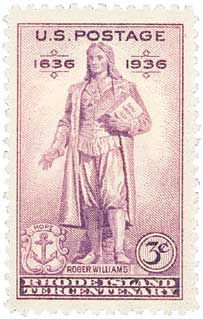
On May 29, 1790, Rhode Island became the last of the original 13 colonies to ratify the U.S. Constitution, making it our 13th state.
When the first Europeans arrived, Algonquian Indians lived in the area that is now Rhode Island. A Portuguese navigator, Miguel de Cortereal, may have reached the Rhode Island coast as early as 1511. Giovanni da Verrazano, an Italian explorer working for France, reached Narragansett Bay in 1524. Verrazano may have given Rhode Island its name, after the Island of Rhodes in the Mediterranean Sea.
A minister, Roger Williams, established the first permanent white settlement at Providence in 1636. Williams was forced to leave Massachusetts due to his demands for greater religious freedom. He bought land for the settlement from Canonicus and Miantonomo, two Algonquian Indian chiefs.
Other colonists seeking religious and political freedom also came to Rhode Island. In 1638, colonists from Massachusetts founded Pocasset on Aquidneck Island (now Rhode Island). This settlement soon split. Some of the group, led by William Coddington and John Clarke, moved south and formed Newport in 1639. Anne Hutchinson led those who remained in Pocasset – they changed the settlement’s name to Portsmouth. In 1643, a group of settlers led by Samuel Gorton and John Greene left Providence to form Warwick. These colonists believed true freedom was possible only through living under English law.
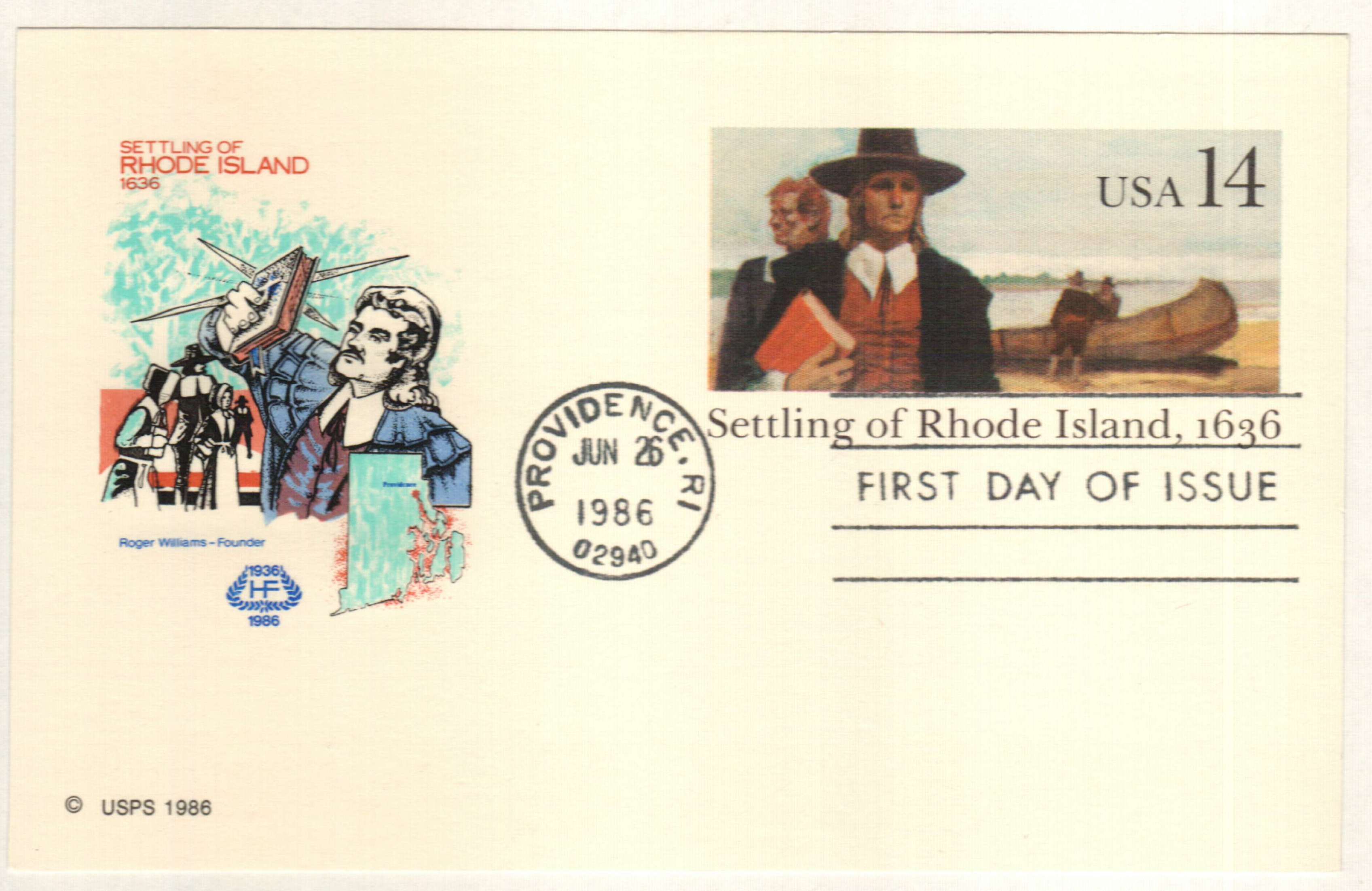
In 1647, and again in 1663, all of these settlements were placed under one charter. Settlements on the mainland were called Providence Plantations. Thus the 1663 charter was titled Charter of Rhode Island and Providence Plantations. Today, Rhode Island’s official name is State of Rhode Island and Providence Plantations – giving the smallest state the longest official name.
Rhode Island entered a period of great prosperity during the 1700s. The fertile coastal and island soils made excellent farmland. Plantations worked by African slaves were established, much like those in the South. Merchants established large fleets and shipping businesses. The slave trade also proved very profitable. However, in 1774, before the outbreak of the Revolutionary War, Rhode Island became the first colony to outlaw slavery.
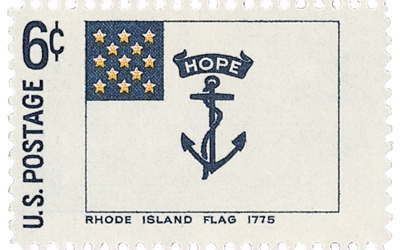
With its interest in trade and shipping, Great Britain’s laws restricting Colonial trade and severe taxes particularly hurt Rhode Island. In fact, one of the first actions against the British was staged in Rhode Island – the burning of the British ship Liberty at Newport in 1769.
British troops occupied Newport from December 1776 until October 1779, raiding the colony’s coast several times, yet no major battles were fought in Rhode Island. However, the colony did contribute a great number of soldiers and military leaders. Notable leaders include: Stephen Hopkins, who helped organize the Continental Navy; Esek Hopkins, the first commander in chief of the navy; and Nathanael Greene, one of the great leaders of the Continental Army.
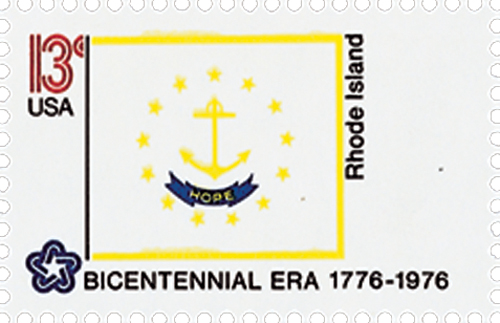
Rhode Island declared its independence from Great Britain on May 4, 1776, making it the first colony to take this step. On July 9, 1778, the colony ratified the Articles of Confederation. Rhode Island was the last of the original 13 colonies to ratify the U.S. Constitution. It delayed ratification until the Bill of Rights was to be added to the Constitution. Even then, the state convention ratified the Constitution by a narrow margin, 34 to 32, on May 29, 1790 – the day it became a state.
The Industrial Revolution came early to Rhode Island. In 1790, an English textile worker, Samuel Slater, brought the secret of water-powered spinning machines to Providence, where Moses Brown employed Slater. This allowed the state’s textile industry to grow rapidly. In 1794, Nehemiah Dodge of Providence discovered a method of plating cheap metals with gold and silver. This was valuable in the manufacture of affordable jewelry. The whaling industry also supplied revenue from the sale of oil and candles.
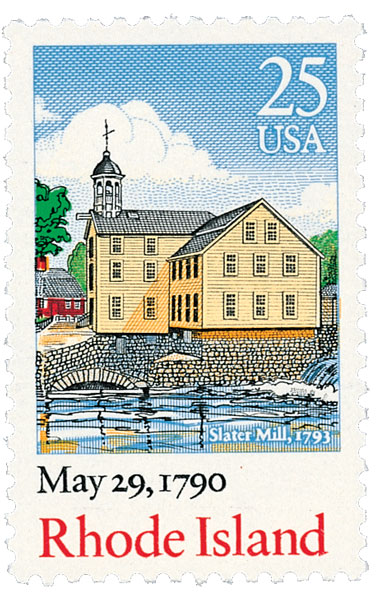
As industry grew, so did Rhode Island’s cities. The state’s farmers, as well as immigrants from Canada and Europe, flocked to cities by the thousands. However, the state’s constitution only allowed property owners the right to vote. Therefore, rural areas had great power, yet most of the people lived in the cities. This led to the Dorr Rebellion. Thomas Dorr led an effort to establish a new government. Dorr and his followers failed, but they did help to achieve reforms to the constitution in 1843.
Rhode Island provided a large amount of soldiers for the Union effort in the Civil War – over 24,000 served. One of the most prominent Rhode Islanders to serve was Ambrose E. Burnside. Burnside entered the war as a colonel in the Rhode Island volunteer regiment – his brigade opened the first Battle of Bull Run. Later, he led an expedition that seized areas of the North Carolina coast. His military career peaked when he commanded the Army of the Potomac as a Major General. Burnside went on to serve as the governor and as a U.S. senator for Rhode Island.
Between 1870 and 1900, Rhode Island’s population nearly doubled. During the 1800s, products from Rhode Island were sold all over the world. Construction of the Newport Naval Station in 1883, and the Naval War College, the navy’s highest educational institution, in 1884, increased the state’s economic prosperity.
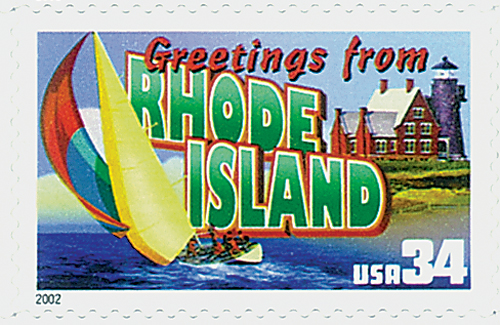
With the exception of the Great Depression, Rhode Island’s economy has experienced great growth throughout its modern history. Manufacture of electronics, chemicals, machinery, and plastic goods have helped to replace the textile industry, and give the state a broader economic base. Tourism has become more important to the state in recent years. Many roads and bridges have been built to provide access to remote areas.
Rhode Island is also gaining prominence as a world center for oceanographic research. The University of Rhode Island’s ocean research project has been recognized as the finest in the United States.
Rhode Island
34¢ Greetings From America
City: New York, NY
Quantity: 200,000,000
Printed by: American Packaging Corp for Sennett Security Products
Printing Method: Photogravure
Perforations: Serpentine Die Cut 10.75
Quantity: 200,000,000
Rhode Island Becomes 13th State

On May 29, 1790, Rhode Island became the last of the original 13 colonies to ratify the U.S. Constitution, making it our 13th state.
When the first Europeans arrived, Algonquian Indians lived in the area that is now Rhode Island. A Portuguese navigator, Miguel de Cortereal, may have reached the Rhode Island coast as early as 1511. Giovanni da Verrazano, an Italian explorer working for France, reached Narragansett Bay in 1524. Verrazano may have given Rhode Island its name, after the Island of Rhodes in the Mediterranean Sea.
A minister, Roger Williams, established the first permanent white settlement at Providence in 1636. Williams was forced to leave Massachusetts due to his demands for greater religious freedom. He bought land for the settlement from Canonicus and Miantonomo, two Algonquian Indian chiefs.
Other colonists seeking religious and political freedom also came to Rhode Island. In 1638, colonists from Massachusetts founded Pocasset on Aquidneck Island (now Rhode Island). This settlement soon split. Some of the group, led by William Coddington and John Clarke, moved south and formed Newport in 1639. Anne Hutchinson led those who remained in Pocasset – they changed the settlement’s name to Portsmouth. In 1643, a group of settlers led by Samuel Gorton and John Greene left Providence to form Warwick. These colonists believed true freedom was possible only through living under English law.

In 1647, and again in 1663, all of these settlements were placed under one charter. Settlements on the mainland were called Providence Plantations. Thus the 1663 charter was titled Charter of Rhode Island and Providence Plantations. Today, Rhode Island’s official name is State of Rhode Island and Providence Plantations – giving the smallest state the longest official name.
Rhode Island entered a period of great prosperity during the 1700s. The fertile coastal and island soils made excellent farmland. Plantations worked by African slaves were established, much like those in the South. Merchants established large fleets and shipping businesses. The slave trade also proved very profitable. However, in 1774, before the outbreak of the Revolutionary War, Rhode Island became the first colony to outlaw slavery.

With its interest in trade and shipping, Great Britain’s laws restricting Colonial trade and severe taxes particularly hurt Rhode Island. In fact, one of the first actions against the British was staged in Rhode Island – the burning of the British ship Liberty at Newport in 1769.
British troops occupied Newport from December 1776 until October 1779, raiding the colony’s coast several times, yet no major battles were fought in Rhode Island. However, the colony did contribute a great number of soldiers and military leaders. Notable leaders include: Stephen Hopkins, who helped organize the Continental Navy; Esek Hopkins, the first commander in chief of the navy; and Nathanael Greene, one of the great leaders of the Continental Army.

Rhode Island declared its independence from Great Britain on May 4, 1776, making it the first colony to take this step. On July 9, 1778, the colony ratified the Articles of Confederation. Rhode Island was the last of the original 13 colonies to ratify the U.S. Constitution. It delayed ratification until the Bill of Rights was to be added to the Constitution. Even then, the state convention ratified the Constitution by a narrow margin, 34 to 32, on May 29, 1790 – the day it became a state.
The Industrial Revolution came early to Rhode Island. In 1790, an English textile worker, Samuel Slater, brought the secret of water-powered spinning machines to Providence, where Moses Brown employed Slater. This allowed the state’s textile industry to grow rapidly. In 1794, Nehemiah Dodge of Providence discovered a method of plating cheap metals with gold and silver. This was valuable in the manufacture of affordable jewelry. The whaling industry also supplied revenue from the sale of oil and candles.

As industry grew, so did Rhode Island’s cities. The state’s farmers, as well as immigrants from Canada and Europe, flocked to cities by the thousands. However, the state’s constitution only allowed property owners the right to vote. Therefore, rural areas had great power, yet most of the people lived in the cities. This led to the Dorr Rebellion. Thomas Dorr led an effort to establish a new government. Dorr and his followers failed, but they did help to achieve reforms to the constitution in 1843.
Rhode Island provided a large amount of soldiers for the Union effort in the Civil War – over 24,000 served. One of the most prominent Rhode Islanders to serve was Ambrose E. Burnside. Burnside entered the war as a colonel in the Rhode Island volunteer regiment – his brigade opened the first Battle of Bull Run. Later, he led an expedition that seized areas of the North Carolina coast. His military career peaked when he commanded the Army of the Potomac as a Major General. Burnside went on to serve as the governor and as a U.S. senator for Rhode Island.
Between 1870 and 1900, Rhode Island’s population nearly doubled. During the 1800s, products from Rhode Island were sold all over the world. Construction of the Newport Naval Station in 1883, and the Naval War College, the navy’s highest educational institution, in 1884, increased the state’s economic prosperity.

With the exception of the Great Depression, Rhode Island’s economy has experienced great growth throughout its modern history. Manufacture of electronics, chemicals, machinery, and plastic goods have helped to replace the textile industry, and give the state a broader economic base. Tourism has become more important to the state in recent years. Many roads and bridges have been built to provide access to remote areas.
Rhode Island is also gaining prominence as a world center for oceanographic research. The University of Rhode Island’s ocean research project has been recognized as the finest in the United States.










